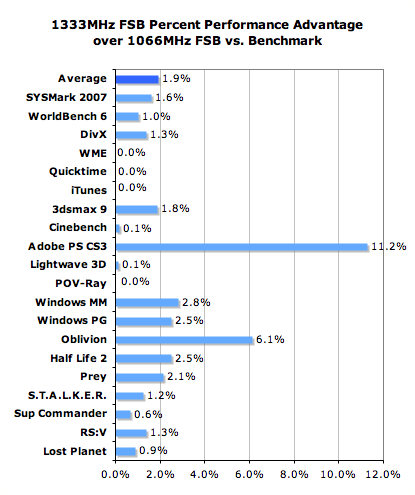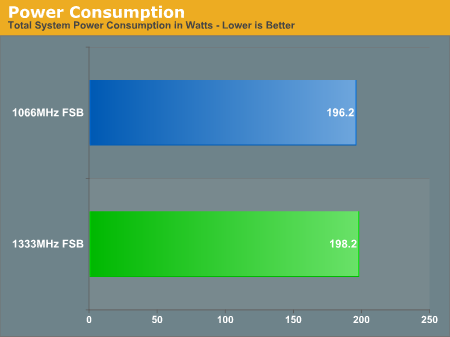Intel Core 2 Duo E6750 Preview: The Desktop Gets a 1333MHz FSB
by Anand Lal Shimpi on June 25, 2007 2:57 AM EST- Posted in
- CPUs
Tell it To Me Straight Anand: Is it Any faster?
The beauty of these FSB launches at equivalent clock speeds is that we show you a single chart that summarizes the performance impact of the faster FSB across our entire bench suite. At one single glance you can figure out whether or not there's anything worth getting excited about:

Overall, the 1333MHz FSB doesn't do much for dual core processors. Over the 20 benchmarks we sampled for this chart, the 1333MHz FSB gave us an average improvement of 1.9% over the 1066MHz FSB. There are two unique outliers in the chart: Oblivion with a 6.1% improvement and Photoshop CS3 with an 11.2% increase in performance. Both of these benchmarks are hand timed so the variance between runs is greater than normal, and we suspect that may be the reason for some of the larger than normal impact of the faster FSB but after multiple subsequent runs we were left with the same results.
Keep in mind the fundamental rules of FSB performance: clock speed, number of cores, memory bandwidth and microprocessor architecture all play important roles in the impact of a faster FSB. The clock speeds Intel is launching its 1333MHz FSB processors are basically the same ones that Intel first introduced the Core 2 at; we weren't FSB bottlenecked back then, thus there's no reason to expect a huge increase in performance by bumping the FSB today. Quad-core CPUs may see a performance boost, but we'll have to wait until later to find out exactly what that improvement would be; we have a feeling that the overall performance impact will be similarly unimpressive given the relatively limited number of desktop applications that can take full advantage of four cores.
As Intel ramps up clock speed and continues its transition to quad-core the 1333MHz FSB will be more important, but today it's by no means a necessary feature. There's a bigger performance impact from having more L2 cache (e.g. 4MB vs. 2MB) than from the 1333MHz FSB, which is great news for present day Core 2 owners.
Under load, the faster FSB also doesn't increase power consumption much at all:

An increase of 2W isn't much for a desktop platform, although Intel could arguably implement a variable speed FSB from its latest Centrino platform if power consumption ever becomes an issue.










42 Comments
View All Comments
yacoub - Monday, June 25, 2007 - link
Cool, so basically my E4400 oc'd to 3.0GHz @ 1333MHz fsb is essentially an E6850 with half the L2 cache (2MB vs 4MB). For only $135 it's giving me quite the bang-for-the-buck. :DJmsAndrsn - Monday, June 25, 2007 - link
Cool, so basically my E4400 oc'd to 3.0GHz @ 1333MHz fsb is essentially an E6850 with half the L2 cache (2MB vs 4MB). For only $135 it's giving me quite the bang-for-the-buck. :DActually, an E4400 overclocked to 1333 FSB would be at 3.33GHz. An E4300 @ 1333 FSB would be 3.0GHz
yacoub - Tuesday, June 26, 2007 - link
sorry, forgot to mention i dropped the multiplier to 9x. =)Not enough heatsink to cool 3.3Ghz to a temp i was satisfied with.
tim75 - Monday, June 25, 2007 - link
Slightly off topic, but since the 1333 FSB has 10.6 GB/s bandwidth (1333 x 64bit) I can use DDR-667 in dual channel mode(also 10.6 GB/s[667 x 128 bit]) without any performance hit right?bamacre - Monday, June 25, 2007 - link
Yup. At stock speeds you'll only need 667mhz DDR2 for the 1333mhz FSB C2D's. And of course 533mhz DDR2 for 1066mhz C2D's.gigahertz20 - Monday, June 25, 2007 - link
Gary Key,I've been waiting for your promised P35 roundup article you mentioned in your May 30th "Gigabyte GA-P35T-DQ6: DDR3 comes a knocking, again" article. Any word on what day this week it will be posted? I'm eagerly waiting the release of the article so I finally buy my long awaited Core 2 Duo setup, I just need a solid motherboard to go with it.
yacoub - Monday, June 25, 2007 - link
If you give up waiting, go for the MSi P6N-SLI Platinum. Awesome 650i-SLI board. She's rock solid for me @ 1333MHz fsb, only voltage increase is on the vcore, and I'm running 4GB dual-channel paired in the four DIMM slots. Fast and stable, just as I'd wanted.gigahertz20 - Monday, June 25, 2007 - link
Is the article on time to be published this week?Deusfaux - Monday, June 25, 2007 - link
I assume your comparisons of the 2 FSBs are keeping end clock speed the same?sc3252 - Monday, June 25, 2007 - link
Why don't your new articles have tests where you run multiple applications at the same time, I really enjoyed reading older articles how the cpu's stood up to multitasking. Its nice that we have benchmarks showing how much faster the new cpu's are, but I don't think it shows how we will really be using the computer.For example I will be using my computer much different then say playing one game strictly. When I play world of warcraft I will usually have itunes open playing a song, and Firefox open looking up where to turn in my next quest. It would be nice if in future articles you could create a benchmark doing some of those things.